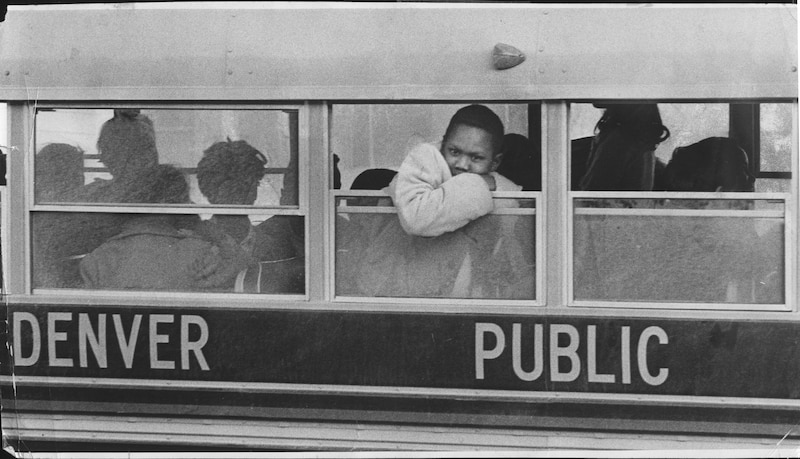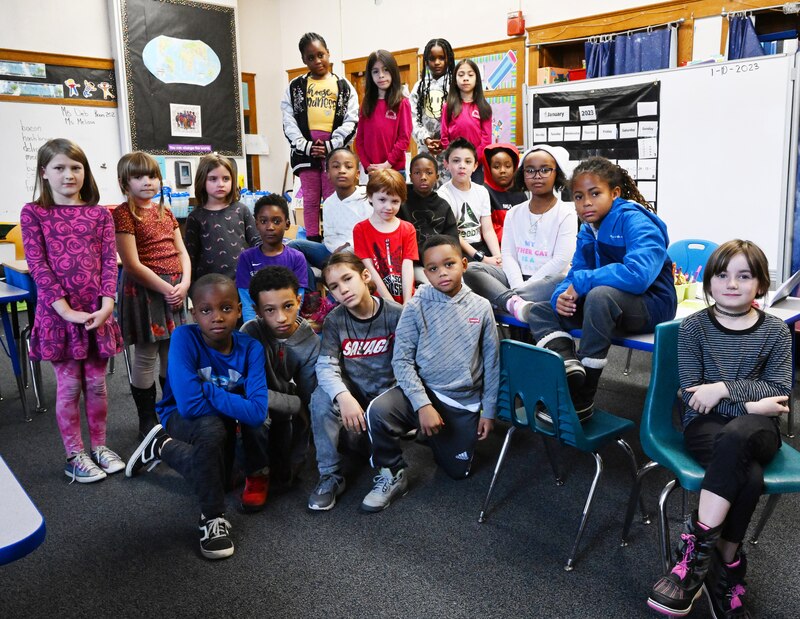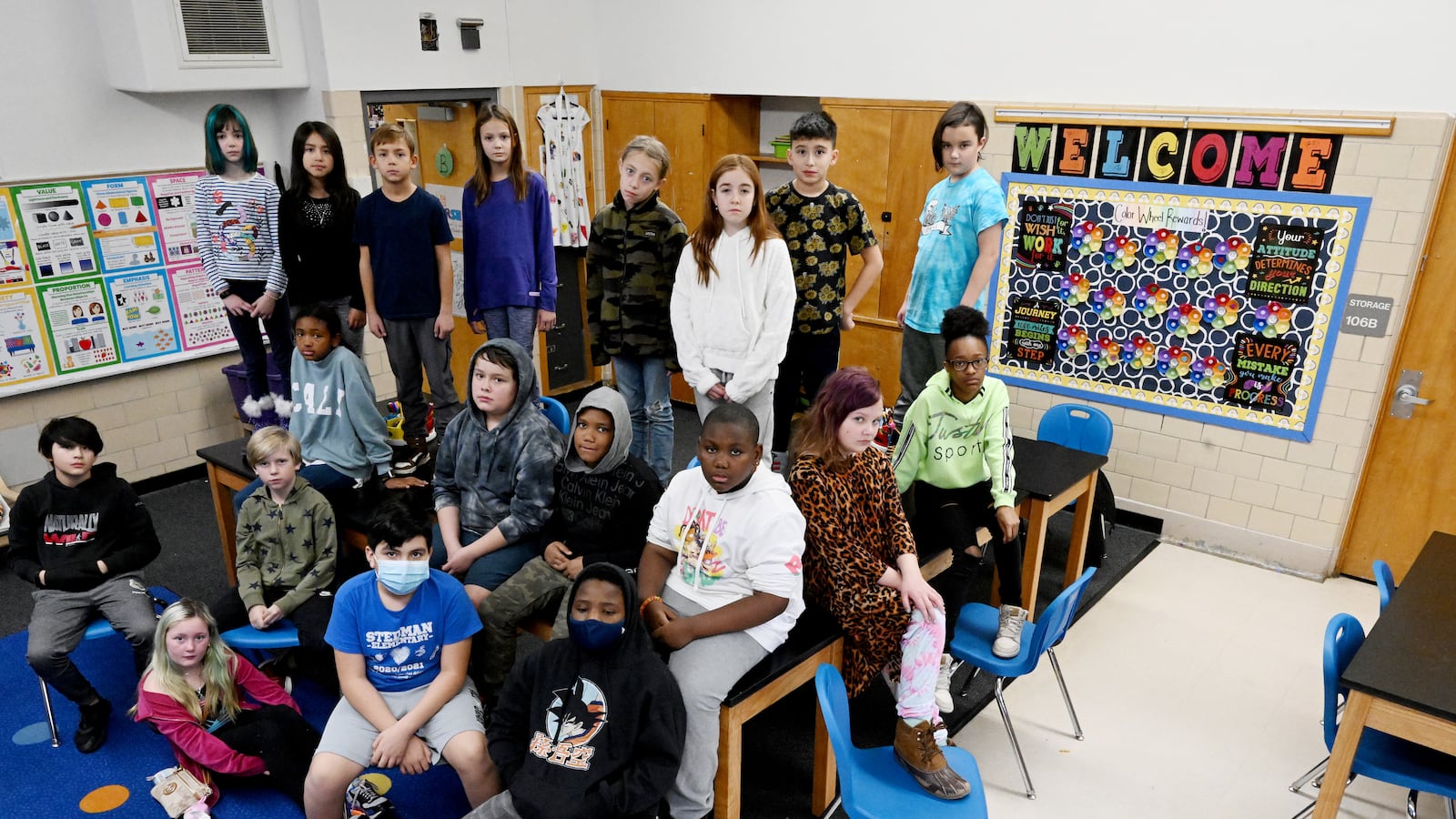Stedman Elementary is one of Denver’s most integrated schools. About a third of its students are Black, a third are Hispanic, and a third are white.
“That happened by accident,” Principal Michael Atkins said, “but we are keeping it by design.”
In the 1960s, Stedman wasn’t integrated at all — and it was no accident. In 1968, 92% of Stedman students were Black and the school was overcrowded. Rather than reassign some Stedman students to mostly white schools nearby, the district brought in trailers.
The segregation at Stedman and at other Denver schools spurred a group of families, led by Wilfred Keyes, a Black father and chiropractor, to sue Denver Public Schools in 1969.
The Keyes case went all the way to the U.S. Supreme Court, the first desegregation case in a major city outside of the South to do so. This year marks 50 years since the high court ordered Denver to desegregate its public schools “root and branch.”
The 1973 ruling made history, even outside Denver. Keyes was what the Supreme Court called a “tri-ethnic case” and was the first to give Hispanic students the same rights to desegregated schools that the Brown v. Board of Education case extended to Black students 19 years earlier.
Keyes also set precedent with regard to intent. The Supreme Court found that the Denver school board’s actions to segregate the schools in the Park Hill neighborhood, including Stedman, showed that the entire Denver district was de facto segregated.
The case also led to a federal consent decree requiring Denver to improve education for Spanish-speaking students, which led to the development of bilingual programming.
The aftermath of the case shaped generations of Denver schoolchildren who were bused in the 1970s, ’80s, and ’90s. They included Atkins, who grew up in Park Hill and played basketball on the Stedman playground on Wednesday nights. But for school, the district bused him to schools located in whiter and wealthier neighborhoods.
Atkins said his educational experience was one of assimilation, tension, and hidden segregation. Even though his middle school was integrated in numbers, the white students were in honors classes and the Black and brown students weren’t.
“The way I lead today has a lot to do with my experiences from the outcomes of the Keyes case,” Atkins said. “I personally learn best in situations where not everyone speaks the same language as me, not everyone looks just like me — different backgrounds. That’s something I want to give my students and families in safe, facilitated ways.”

Keyes case originated in Park Hill
Park Hill was the epicenter of Denver’s school desegregation battle. Beginning in the 1950s and ’60s, Black families were moving east from Five Points to Park Hill, crossing Colorado Boulevard in search of bigger homes on tree-lined streets.
Housing integration could have led to school integration, but the Denver school board took steps to prevent that. It manipulated school boundaries and added temporary classroom trailers to predominantly Black schools. It studied educational equality, passed policies calling for its adoption, and then did nothing to put those policies in place.
In 1960, the district built Barrett Elementary School, just west of Colorado Boulevard from Park Hill Elementary. Denver funneled Black students into the new school, thus ensuring that Park Hill, which had been racially integrated, went back to serving mostly white students.
Rachel Noel’s daughter was reassigned from Park Hill Elementary to Barrett, which opened with an almost all-Black student body. Noel later testified in court that Barrett’s resources and academics were inferior. Her daughter, she said, was learning the same thing at Barrett in fifth grade that she’d learned at Park Hill in fourth grade.
In 1965, Noel became the first Black member elected to the Denver school board. Frustrated by the board’s inaction on integration and reeling from the assassination of Martin Luther King Jr., Noel introduced a resolution in 1968 — now known as the Noel Resolution — that called for “a comprehensive plan for the integration of the Denver Public Schools.”
In a speech she gave more than 20 years later, Noel remembered how the Black community in Denver “exploded” after King’s assassination. Listening to speakers at a meeting call for decision makers to take action, she said she felt they were talking directly to her.
“I knew I was in a position of decision-making,” she said, according to a typed copy of the speech, ”and also I knew that a resolution to integrate the schools was in the making.”
In response to community activism and a new sense of urgency around racial equality, the school board adopted the Noel Resolution 5-2 in May 1968. The board passed three more resolutions in the winter and spring of 1969 that, according to court documents, would have redrawn boundaries to relieve segregation at Barrett, Stedman, and other schools in Park Hill, and established voluntary busing to integrate some schools.
The resolutions sparked a fierce and swift backlash that led to the election of new school board members opposed to integration in May 1969. They promptly voted to repeal the resolutions.
In June, eight families — five Black, one Hispanic, and two white — sued Denver Public Schools. The case became known as Keyes v. School District No. 1.
After years of busing, segregated schools return
Racist retaliation soon followed. Opponents bombed the houses of lead plaintiff Wilfred Keyes, whose family was home but not injured, and of federal Judge William Doyle. About a third of the buses at the district bus depot were destroyed by dynamite.
After the Supreme Court ruled for the families in 1973, Denver created a complex, cross-city system of busing aimed at ensuring each school’s population looked racially similar to the district as a whole. Many white families reacted by leaving for the suburbs and private schools. According to a 1976 report, the number of white students dropped 22% in two years.
But busing did increase integration. Despite the turmoil, some children now say they benefited.
“It enriched my life because I became friends with many people from different cultures and socioeconomic statuses,” Jayne’ Lewis, who is Black and was bused from northeast Denver to Ellis Elementary and other schools in the southeast part of the city, told Chalkbeat in 2019.
“I am still friends with many of these people today.”
The Denver school district repeatedly asked the court to end the desegregation order, and in 1995, a federal judge agreed. Busing stopped in 1996, and not long after, many Denver schools resegregated. Students returned to schools in their neighborhoods, which had remained divided by race and income. Many Denver schools are still segregated today.
School choice, which Denver began promoting in 2012 as part of a strategy to improve the city’s schools and draw families back, allows students to apply to attend any school in the district. Choice could theoretically be used to integrate schools, but it can also be used to prevent it. As the city gentrifies, white families sometimes opt out of nearby schools where most students are Black and Latino in order to attend whiter schools across town.
That’s what was happening at Stedman Elementary when it came time for Andrew Lefkowits to enroll his oldest daughter in kindergarten. Lefkowits grew up in Park Hill and had gone to Stedman in the 1980s, one of only a handful of white children to do so.
Now the father of two kids, Lefkowits and his wife lived in the boundary for the predominantly white Park Hill Elementary, a school bursting at the seams with nearly 700 students and where the PTA raises hundreds of thousands of dollars each year.
In 2016, nearby Stedman had fewer than 250 students. But Lefkowits treasured his experience there and wanted his daughter to have the same. So the family sent her into Stedman, where she was the only white kid in her kindergarten class.
Seven years later, the school has grown to about 425 students and the demographics have changed. Stedman is whiter and its families are wealthier. Though it can’t match Park Hill, Stedman’s PTA is fundraising for a rock climbing wall. And yet Lefkowits said he’s conflicted about how Stedman got there — and how the white population is burgeoning.
“We hit that tipping point,” Lefkowits said, referring to the proportion of white students. “And now as a school, we’ve been trying desperately to slow down the wave as best we can.”

Why Stedman is integrated today
Stedman began integrating after adding a Spanish language immersion program that attracted white families who want their children to become bilingual.
Janeel Williams remembers the shift. Ten years ago, she chose to enroll her son Jakhi in kindergarten at Stedman because she wanted him to have Black teachers. More than half of Stedman students were Black and the staff was diverse. Jakhi, now a freshman in high school, had a Black teacher his first year at Stedman.
Part way through Jakhi’s time at Stedman, several teachers of color left, Williams and others said — and some families of color followed suit. Williams stuck it out, but she had mixed feelings when a former principal introduced the Spanish immersion program.
“A lot of Black families were like, ‘Who is she trying to appeal to? Who is she trying to attract?’” Williams said. “Our families don’t speak two languages.”
White families, on the other hand, “came in droves,” Williams said. While she and other Black parents worried they wouldn’t be able to help their children with their schoolwork if it was in Spanish, Williams said white parents pledged to pay for their own private lessons.
“A lot of the Black families kind of felt abandoned at that point,” she said. “It just seemed like you were bringing in this wonderful program for families who could take advantage of it.”
Lefkowits’ younger daughter started in the Spanish immersion program in preschool, and several years later, he said she can easily converse with native speakers. But he has complicated feelings about the program. Without it boosting Stedman’s enrollment, he worries the school could have been closed, a blow to Black families who’ve attended for generations.
But he also worries that white, privileged families have benefitted from the program the most.
“I think there’s ways in which it becomes an opportunity to hoard [resources] for people with privilege, and it’s another thing to get for our kids to boost their resume,” Lefkowits said.
“There’s promise and peril in dual language.”

How a principal is pushing the Keyes case forward
When Atkins arrived as principal four years ago, he said he saw at Stedman what he’d seen at his own middle school during busing: The school was diverse, but the students were separated. Most white students attended the Spanish immersion program, while most Black and Latino students stuck with the traditional classes.
Atkins set out to change that by going to Black churches on Sundays, visiting Mexican cultural arts centers, and talking to Stedman families “about the power of language and how this opportunity is built for them as well.” That push, he said, helped desegregate Stedman’s programming so that more Black and brown families are now choosing Spanish immersion.
Stedman also is trying other ways to keep its diversity.
Colorado’s Constitution prohibits assigning students to schools “for the purpose of achieving racial balance.” (Denver’s busing was an exception due to the federal court order.) So schools use other measures. Stedman prioritizes students who qualify for subsidized school meals, an indicator of poverty, or who live in a neighborhood where 75% to 100% of children do.
Atkins also tries to make the school a welcoming and affirming place. All Stedman teachers are pushed to examine their biases, and they do training in equity every Friday.
“I personally believe the work that I do is to push the Keyes case forward in a way that is building the capacity of our educators and creating safe spaces for students,” Atkins said.
Parents like Williams help too. Even though her son is now in high school, she continues to recruit for Stedman, where she said Jakhi got an excellent education, despite some of the bumps along the way. She meets with Atkins every year to hash out a game plan for talking to parents at recreation centers, libraries, and the Boys & Girls Club.
Most parents of color are concerned about gentrification, she said, and rising rents have forced many out of Park Hill. But they continue to bring their kids to the neighborhood rec centers, and Williams encourages them to do the same with Stedman. She has confidence it will pay off.
“I see Stedman going up,” she said. “All the way up.”
Melanie Asmar is a senior reporter for Chalkbeat Colorado, covering Denver Public Schools. Contact Melanie at masmar@chalkbeat.org.
Chalkbeat partnered with Historic Denver to examine the legacy of Keyes v. School District No. 1 50 years after this landmark case through the lens of one school.
Historic Denver Inc. is a nonprofit organization that works to promote and protect Denver’s historic places. This article appeared in print in Historic Denver’s quarterly newspaper.


